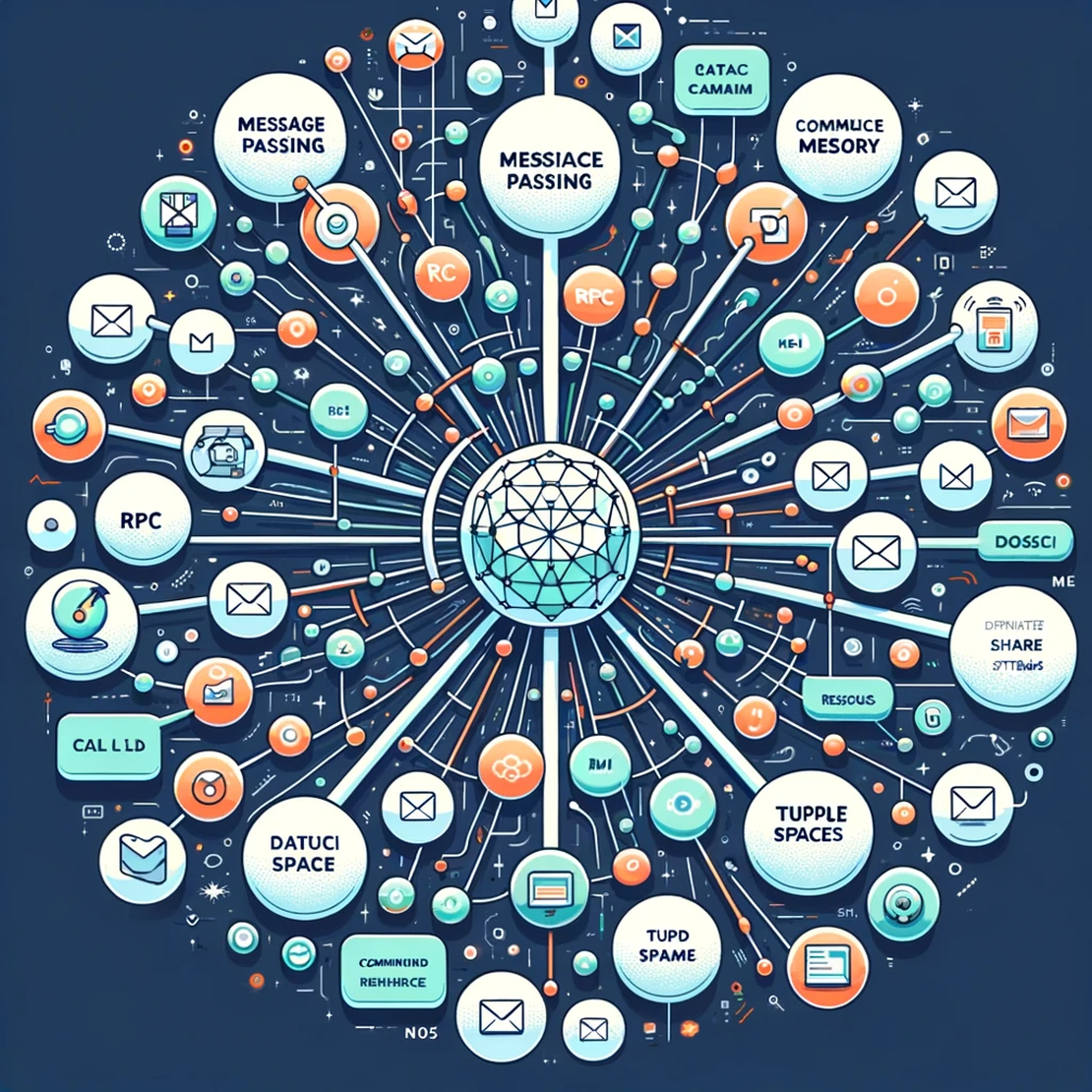
Understanding Communication in Distributed Systems
- Yuhang
- Internet , Cloud
- July 21, 2023
Effective communication is the cornerstone of distributed systems, enabling cooperative processes to function harmoniously. In distributed environments, communication is not just about data exchange; it’s about synchronizing actions, sharing resources, and maintaining consistency across disparate nodes.
The Role of Communication
- Synchronization: Communication in distributed systems is essential for synchronization among processes. This ensures that actions across different nodes are coordinated, maintaining the overall system’s integrity.
- Data Sharing: Another critical aspect is data sharing. Distributed systems often involve multiple processes that need to share data efficiently and reliably to operate cohesively.
Methods of Process Communication
In distributed systems, processes communicate through two primary methods: shared memory and message passing. Both play a pivotal role in how information is exchanged and tasks are coordinated.
Shared Memory
- Concept: Shared memory involves processes communicating by reading and writing to a shared memory space. This method is intuitive as it mimics how processes within a single computer communicate.
- Challenges: However, shared memory in a distributed environment faces challenges such as ensuring consistency and managing concurrent accesses by multiple processes.
Message Passing
- Mechanism: Message passing, on the other hand, involves explicit send and receive operations. Processes exchange information by sending and receiving messages.
- IPC Mechanisms: Inter-Process Communication (IPC) mechanisms, such as pipes, sockets, and queues, are often employed to facilitate message passing. These mechanisms define how data is formatted and transmitted between processes.
Message Passing in Distributed Systems
Message passing serves as the backbone for process communication in many distributed systems. It provides a clear and structured way for processes to exchange information.
Core Operations
- Send and Receive: The basic operations in message passing are send() and receive(). The send() operation transmits a message to a receiver, while the receive() operation retrieves the message.
- Blocking and Non-Blocking: These operations can be either blocking, where the process waits until the operation completes, or non-blocking, where the process continues its execution without waiting.
Variations and Issues
- Data Representation: Ensuring consistent data representation across different systems is crucial. This involves handling data structures, encoding, and serialization.
- Handling Pointers: Dealing with pointers in message passing is complex, as direct memory references don’t translate across different address spaces. Special mechanisms are required to handle these cases.
Communication Modes
Different communication modes in distributed systems cater to various needs, from simple data exchange to complex control operations.
Data-Oriented vs. Control-Oriented Communication
- Data-Oriented: This mode focuses on the exchange of data between processes. It’s used in scenarios where sharing information is the primary goal, like in database operations.
- Control-Oriented: In contrast, control-oriented communication deals with coordination and control among processes. It’s essential in scenarios requiring synchronization and task management across nodes.
Synchronous vs. Asynchronous Communication
- Synchronous Communication: This involves processes waiting for a response after sending a message, ensuring a tightly coupled communication pattern. It’s useful for operations requiring immediate confirmation or reply.
- Asynchronous Communication: Here, processes don’t wait for an immediate response. This decouples the sender and receiver, allowing for more flexible interaction patterns. It’s suitable for applications where immediate response is not critical.
Communication Abstractions
Abstractions in communication help simplify the complexity of distributed systems, making it easier for developers to write and manage distributed applications.
Simplifying Communication
- Abstraction Layers: Communication abstractions provide layers that hide the underlying network details from application developers. This allows them to focus on the application logic rather than the intricacies of network communication.
- Middleware Systems: Middleware systems play a crucial role in implementing these abstractions. They provide a set of services and APIs that manage communication details, such as connection handling, data serialization, and error recovery.
Role of Middleware
- Interoperability: Middleware facilitates interoperability between different systems and platforms, essential in heterogeneous distributed environments.
- Scalability and Flexibility: By abstracting communication details, middleware provides scalability and flexibility, enabling applications to adapt to varying loads and network conditions.
Message-Oriented Communication
Message-oriented communication is a model where messages are the primary means of information exchange, offering a flexible approach to process interaction in distributed systems.
Concept and Implementation
- Message Queues: This model often utilizes message queues, where messages are stored temporarily, allowing asynchronous communication between processes.
- Loose Coupling: Message-oriented communication enables loose coupling between sender and receiver, as they don’t need to interact directly or be available simultaneously.
Message-Oriented Middleware (MOM)
- Functionality: MOM provides functionalities such as message queuing, topic subscription, and message filtering. This facilitates efficient and reliable message exchange in distributed environments.
- Applications: MOM is widely used in scenarios like event notification systems, where it’s crucial to disseminate information reliably and efficiently among multiple recipients.
Remote Procedure Call (RPC)
Remote Procedure Call is a communication method in distributed systems that allows a program to cause a procedure to execute on another computer as if it were a local call.
Concept and Implementation
- Seamless Interaction: RPC abstracts the communication process, enabling procedures to be called remotely with the same syntax as local calls. This abstraction simplifies the development of distributed applications.
- Client-Server Model: Typically used in a client-server model, RPC allows clients to invoke procedures on a server as if they were local procedures, with the network communication handled transparently.
RPC Frameworks and Challenges
- Frameworks: Various frameworks and standards support RPC implementation, such as XML-RPC, JSON-RPC, and gRPC, each offering different features and compatibility levels.
- Heterogeneous Environments: One of the challenges with RPC is dealing with heterogeneous environments where different systems may have varying data formats and calling conventions. This requires additional mechanisms for data serialization and deserialization.
Remote Method Invocation (RMI)
Remote Method Invocation extends the concept of RPC by incorporating object-oriented principles, allowing objects to interact in a distributed environment.
Transition from RPC to RMI
- Object Metaphor: RMI uses the object metaphor, enabling remote objects to be manipulated as if they were local. This approach is more natural in object-oriented programming, providing a higher level of abstraction.
- State Management and Location Transparency: RMI provides better support for managing the state of remote objects and offers location transparency, where the actual location of the object is abstracted from the caller.
Advantages over RPC
- Stateful Interactions: Unlike RPC, which is typically stateless, RMI can maintain state information across method calls, enhancing the interaction between distributed components.
- Ease of Use in Object-Oriented Languages: RMI integrates seamlessly with object-oriented languages like Java, making it easier to develop and maintain distributed applications in these languages.
The Challenges of Transparency in Communication
While RPC and RMI provide a high level of transparency in communication, they also present unique challenges and limitations.
Limitations of RPC and RMI
- Differences from Local Calls: Despite their design to mimic local calls, RPC and RMI differ in aspects like error handling, latency, and partial failure handling, which can complicate application development.
- Complexity Under the Hood: The abstraction provided by RPC and RMI hides the complexities of network communication, but this can lead to a lack of control and understanding of the underlying processes, potentially impacting performance and debugging.
Transparency Challenges
- Network Latency and Failures: One of the significant challenges is dealing with network latency and partial failures, which are not common in local systems but prevalent in distributed environments.
- Error Handling: Error handling in distributed systems is more complex, as it needs to account for a range of network and server issues that do not occur in local environments.
Group Communication
Group communication plays a vital role in distributed systems, particularly in scenarios involving collaborative tasks and resource sharing among multiple processes.
Concept and Application
- Collective Interaction: Group communication refers to the exchange of messages among a group of processes. It’s crucial for tasks that require collective interaction, like consensus building and resource coordination.
- Reliability and Ordering: Ensuring reliable message delivery and maintaining a consistent order of messages are key challenges in group communication.
Importance in Distributed Systems
- Service Discovery: Group communication is essential in service discovery mechanisms, where services need to be located and utilized by multiple clients.
- Event Notification: It also plays a significant role in event notification systems, allowing multiple processes to be informed about specific events simultaneously.
Event-Based Communication
Event-based communication in distributed systems is centered around the decoupling of message senders and receivers, offering flexibility and scalability.
Decoupling Senders and Receivers
- Publish/Subscribe Model: This communication model is often implemented using a publish/subscribe mechanism. Publishers emit events without knowing the subscribers, and subscribers receive events of interest without knowing the publishers.
- Flexibility and Scalability: The decoupling allows for greater flexibility and scalability, as components can be added or removed without affecting the overall system.
Role of Event-Based Systems
- Distributed Event Handling: Event-based systems are used for distributed event handling, where events generated in one part of the system need to be processed by other parts.
- Complex Event Processing: They also facilitate complex event processing, which involves analyzing and responding to patterns of events, crucial in areas like real-time analytics and monitoring.
Distributed Shared Memory (DSM)
Distributed Shared Memory provides an abstraction in distributed systems, enabling processes on different machines to share a virtual memory space.
Concept of DSM
- Shared Virtual Memory: DSM creates a shared virtual memory space that is accessible by all processes in the distributed system. This simplifies the programming model as it mimics the shared memory concept in single-processor systems.
- Consistency Models: Maintaining consistency in DSM is challenging. Various consistency models like sequential, causal, and eventual consistency are employed to manage how updates to the shared memory are propagated and seen by other processes.
Challenges and Design Considerations
- Synchronization and Latency: DSM systems need to effectively handle synchronization issues and latency, as data may need to be transferred over a network.
- Scalability: Designing a DSM system that scales efficiently with the addition of more nodes is a complex task, often requiring sophisticated algorithms for memory management and data replication.
Tuple Spaces and Streams in Communication
Tuple spaces and streams offer unique approaches to communication in distributed systems, facilitating data sharing and continuous media communication.
Tuple Spaces as a Generalization of DSM
- Concept of Tuple Spaces: Tuple spaces are an abstract model of shared memory, where tuples (data elements) can be written, read, and taken from a shared virtual space. This model extends the concept of DSM by providing a more flexible and associative form of data sharing.
- Asynchronous and Decoupled Communication: Tuple spaces allow for asynchronous and decoupled communication, where processes can interact without needing to be online simultaneously. This is especially useful in distributed environments where processes operate at different times and rates.
Streams in Continuous Media Communication
- Handling Continuous Media: Streams are crucial for continuous media communication in distributed systems, such as audio, video, and real-time data feeds.
- Quality of Service (QoS): Managing streams involves dealing with Quality of Service (QoS) requirements, ensuring that data is delivered in a timely and consistent manner, which is essential for applications like video conferencing and online gaming.
Conclusion
The landscape of communication in distributed systems is rich and varied, encompassing a range of techniques and models from RPC and RMI to DSM and tuple spaces. Each method has its unique advantages and challenges, catering to different requirements and scenarios in distributed computing.
Summarizing the Significance
- Effective Communication: Effective communication is the linchpin of distributed systems. The choice of communication method can significantly impact the performance, scalability, and reliability of a distributed application.
- Future Trends and Developments: As technology continues to evolve, so too will the methods and models of communication in distributed systems. Keeping abreast of these changes is crucial for developers and IT professionals working in this field.
Looking Ahead
- Continued Innovation: The field of distributed systems will continue to see innovation in communication methods, driven by the need for more efficient, reliable, and scalable systems.
- Emerging Technologies: Emerging technologies like 5G, IoT, and edge computing will further influence the development of communication models, offering new opportunities and challenges in distributed system design.


